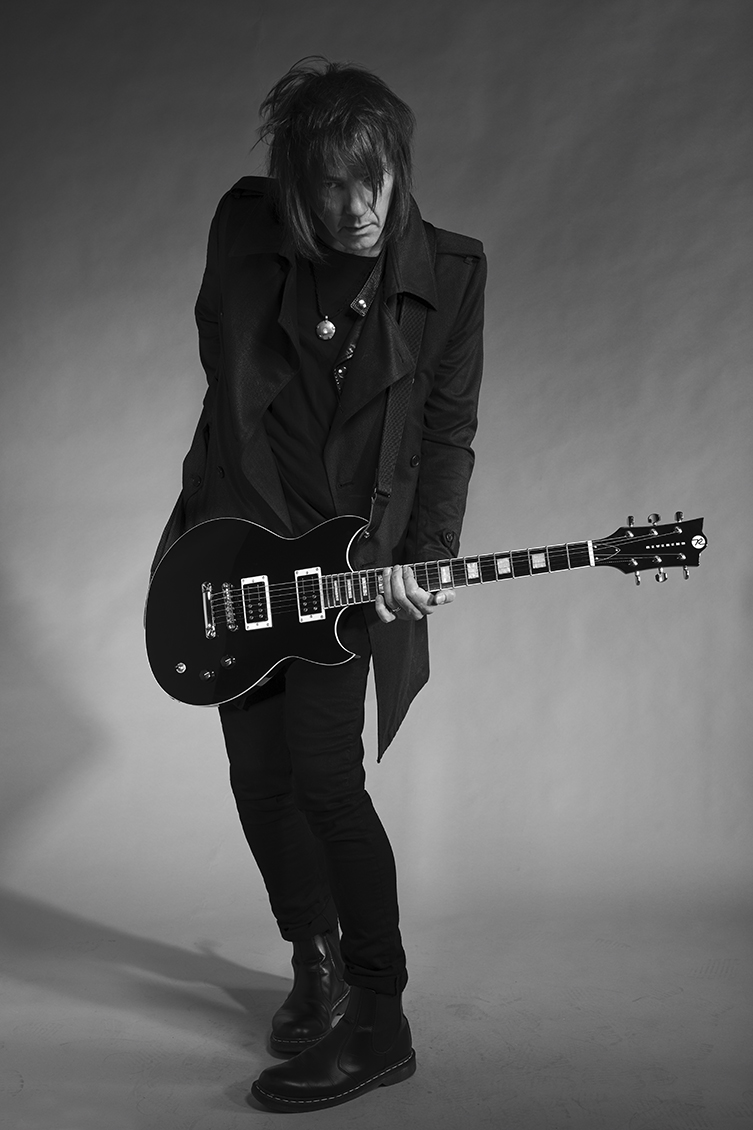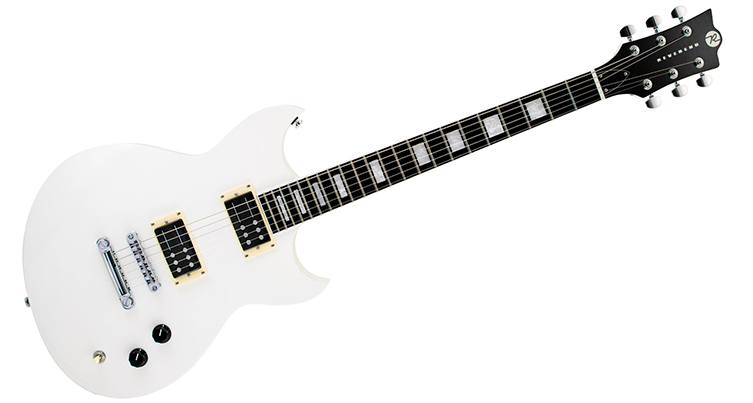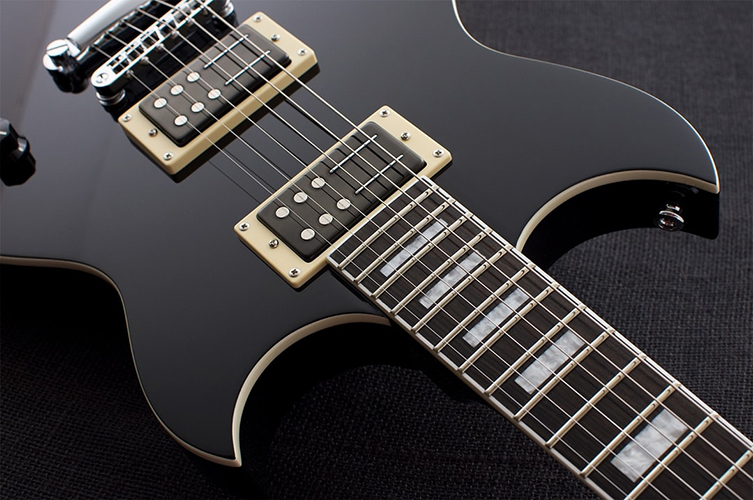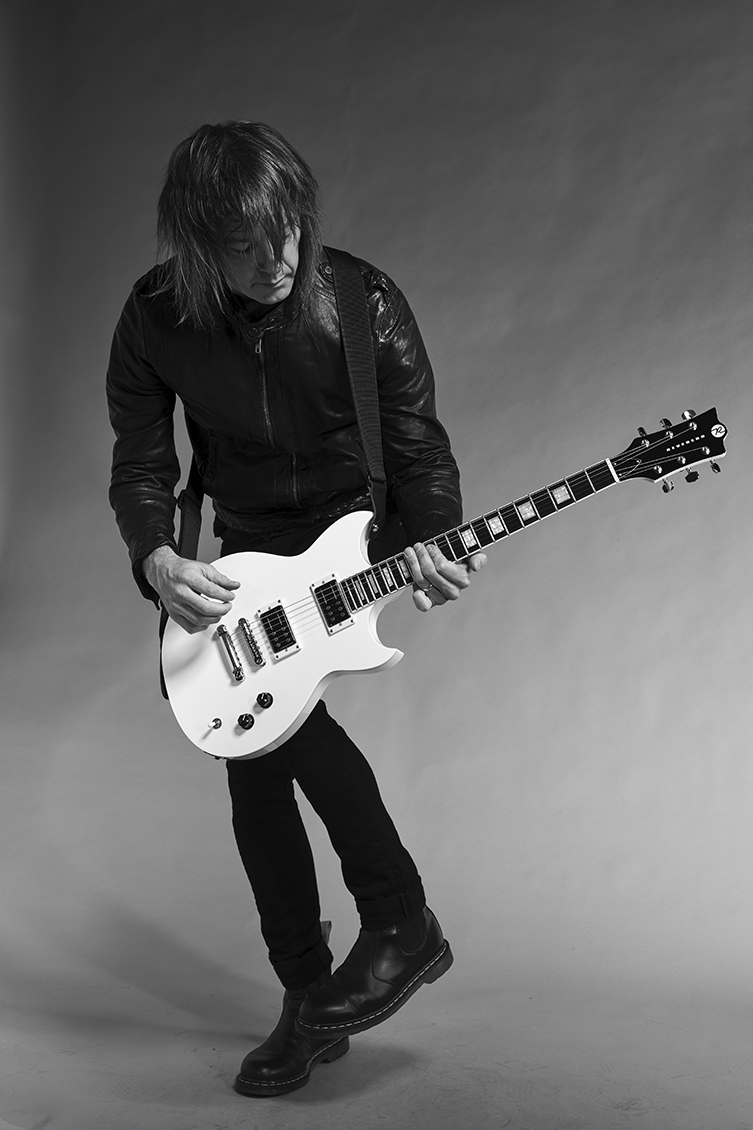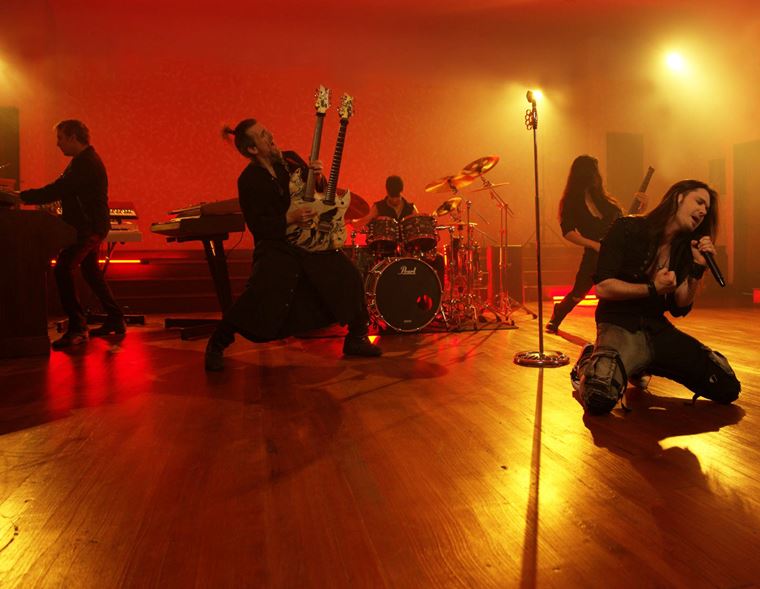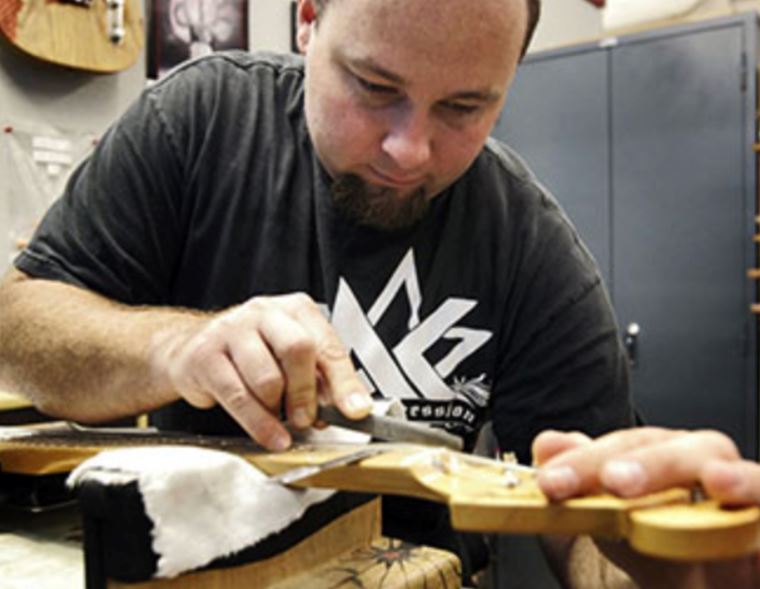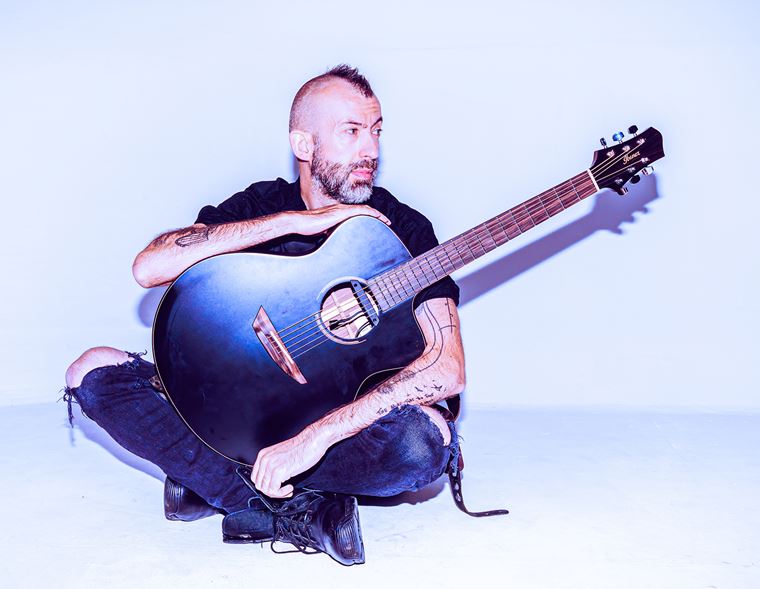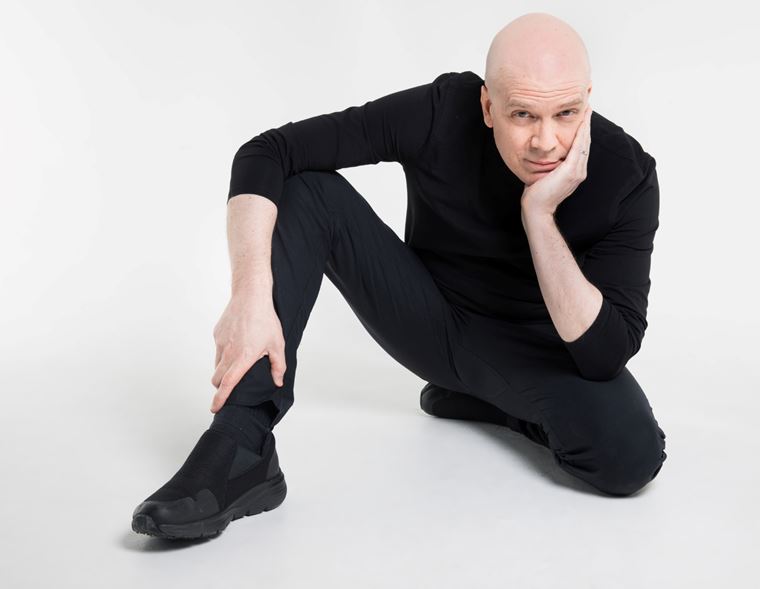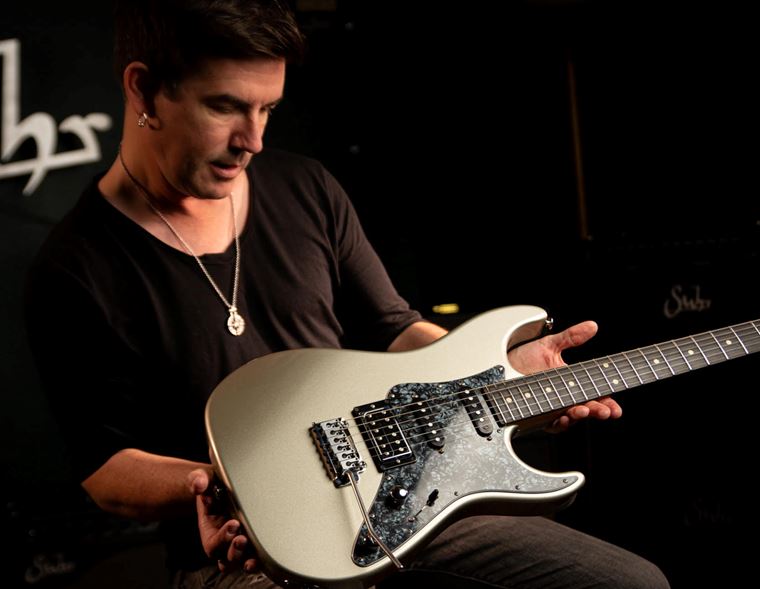The guitarguitar Interview: Nine Inch Nails' Robin Finck
Published on 13 March 2020
Robin Finck is the most underrated guitarist in all of Rock. This intense, charismatic performer has not only served as guitarist for Nine Inch Nails on nearly every tour they’ve done since 1994, he was also a long time member of Guns ‘n’ Roses (off and on for ten years, including the making of Chinese Democracy), a touring guitarist for the Cirque Du Soleil, and a contributor/collaborator to records by Gary Numan and Cee-Lo Green!
AND he has made music for soundtracks to the John Carpenter movie Ghosts of Mars and the video game NOCT.
That’s some CV! Robin, it seems, manages to fit rather a lot into his days!
His most visible role is undoubtedly as Trent Reznor’s most recognisable sideman in Nine Inch Nails. Live, NIN are a force to be reckoned with, a real sci-fi hurricane of sound. As on record, their symphonic, fuzzed-out sonic soundscapes continue to enthral, bewitch and intimidate in equal measures. As a performer, Finck brings intensity and passion to the stage, as well as world-class musicianship. His tall frame contorts and poses like a circus-trained dervish, blasting out machine gun riffs and otherworldly howls from his guitars as the rest of the band describe, through their instruments, what can only be described as a ‘hostile future’. It’s beautiful stuff, in a dark, digital, intense way.
If Reznor and his cohorts tend to lean primarily on keyboards, then they also combat those, most heavily, with chainsaw-edged guitars. The combination is partly what gives the band their massive, three decade plus appeal. As a fan since my early teenage years, I’ve long since wanted to get a conversation in with Robin Finck. Aside from his superb playing, I just wanted to learn more about this truly unique and inspiring individual. If ever an opportunity arose, I knew I’d want to jump on it.
As things turned out, I recently got my chance.
Last year, guitarguitar took on Reverend guitars in our stores. When Reverend CEO Ken Haas came over to the UK on business, we fitted in a fantastic chat about the company (check that conversation out right here) and the other great artists they have on their books. Rumours had been circulating about a Reverend Robin Finck model ever since he’d been spotted playing their guitars on stage with NIN. I figured there was no better person to ask than Ken! Ever the opportunist, I brought up the subject of Robin. Ken kindly showed me a secret prototype image of the guitar (the white one, it’s too cool for words) and mentioned that there may be potential for a conversation on the phone with Robin after the Winter NAMM show had been and gone.
Jump forward two months and I found Ken to be a man of his word. He’d gotten the proposition out to Robin about chatting shop and Robin was happy to oblige. It was happening!
The winter winds were howling in the darkness around guitarguitar Towers in Glasgow when I rang Robin in sunny California. I found him happy to chat and very engaging to talk to. Robin was up for talking about guitars, willing to expand on his preferences for routinely changing the location of his guitar’s controls, and patiently fielding my geek-specific questions on certain NIN guitar sounds. Robin was easy company and actually relatively mild-mannered, which may come as a surprise to those who’ve witnessed the ferocity of him mid-performance! I had kind of anticipated this though, and the bonus is, though he’d take a second or two before answering a question, he’d reply with something excellently expressive and highly quotable!
I enjoyed a fantastic conversation, and though we didn’t have too long together, he came up with plenty of great insights and details for all NIN fans out there. I avoided obvious stuff like ‘What’s it like to work with Trent Reznor?’, though I suppose in retrospect it’s a legitimate enough question. Also, we just didn’t have the available time to go into his work with Guns ‘n’ Roses or, more interestingly, Cirque du Soleil. Maybe another time!
In the meantime, here is our conversation in full, taking in string gauges, Buster Keaton and the Rock ‘n’ Roll Hall of Fame...
Guitarguitar: Hi Robin, thank you very much for agreeing to talk to me today!
Robin Finck: It’s my pleasure! Thank you for your interest.
GG: No, not at all! So, I figure we may as well begin with your relationship with Reverend guitars. How did it all come about?
RF: Yeah, I saw these Reverend guitars on the wall at the Chicago Music Exchange one time when I was there a number of years ago. I think it was the Special Agent I was looking at? Mismatched pickup sort of thing.
GG: Oh yeah.
RF: And, that’s how they came into my awareness, and I sought them out on the internet. I was turned on by their design and so introduced myself to Ken (Haas, CEO of Reverend). Eventually I met Joe (Reverend designer) and the rest of the team at NAMM some years back. I looked into Mirr Music Co (the South Korean company who manufactures the guitars for Reverend – Ray) and read good things there. I started playing their guitars during the last Nine Inch Nails cycle, which was maybe a year ago by now, or more. I really just fell in love with them! I have quite a few guitars at rehearsals that I’m fortunate enough to draw from: once we started working the Reverends into the rotation, in between Les Pauls and Teles, I just found myself time and again talking with my tech, looking down the titles on the setlist and saying ‘let’s try the Reverend on this one, and...give it to me on this one. I’d rather play it here, too!’ They sort of just started populating the entirety of the list.
GG: Oh, cool!
RF: And I’ll tell you also: Lonnie (guitar tech) loves them! Every time they came off the truck and out of the case, they travelled really well: they had little-to-no maintenance issues, stayed in tune, sounded great and they’re really comfortable, which I’m allowing myself to enjoy, weirdly. I had picked up an aversion to contours along the way somewhere, but I’ve come around.
GG: That’s half the battle, I suppose: getting your tech to love them!
RF: Yeah.
GG: So, your new signature model is absolutely gorgeous! It’s based on the Sensei, right?
RF: Yeah, the Sensei is what I was playing last go-around with Nails. I’d made some very minor adjustments: like, I moved the pots around a little bit, lost the tone pot so that I could move the volume pot further from the bridge, small stuff. Joe and Ken suggested to me ‘well, why doesn’t Reverend make all these kinda tweaks that you’ve made to the Sensei, and offer it to the world, as the Robin Finck Signature!’ I was flattered at the notion.
GG: Yeah! That’s awesome! A lot of those changes you mentioned there: you used to do those to your Les Pauls, didn’t you? I always remember seeing you’d moved the position of the Les Paul pickup selector and that type of thing, is that right?
RF: Years ago, I started moving the toggle, well, I didn’t do it myself – my friends moved it for me - on the Les Paul pickup selector down into one of the tone positions that I wasn’t using. I just got really used to that toggle not being there. When I’d pick up a guitar that had a toggle, it was kind of a foreign object, always stabbing at me. Actually, used to be the whole neck pickup was removed and covered with tape to keep water out of the thing. Way, way back it was either, ‘the guitar is working or not working’. One pickup and ‘on’ was all I was shoving around out there. I’ve grown so terribly sophisticated as to now employ one of two functioning pickups.
GG: Haha, yeah!
RF: I really rely on that bass contour: it’s one of the unique features that I really use from song to song, or from part to part. It’s a very versatile sounding guitar because of it. And it really causes pedals to react differently in recording environments.
GG: The bass contour: for an example, would that be where you would want to clean up your sound? Take the bottom end out of it?
RF: Yeah, it’s great for someone who’s maybe chugging some fuzzy 8th notes, or 16th notes to bring some clarity to the picking.
GG: Ah, interesting!
RF: You know? Without losing volume. It really tightens up the bottom. I guess what it is, is a sort of high-pass filter. I’m surprised I don’t see it as standard on more guitars. Maybe I shouldn’t be saying that...
GG: Haha, I think you’re right about the high-pass filter.
RF: But I’m usually kinda all-or-nothing with it. (I start laughing) It has some subtle variances in the positioning of it, but I’m sort of full ‘on’ or full ‘off’.
GG: That’s interesting how you mention about how the heavier bits are the parts that often benefit from you taking the bottom out of your sound. I suppose if you’re playing busier, you may need the guitar to respond quicker. Would that be it?
RF: That or even going from a verse to a chorus or something. You know, it’s subtle and I enjoy it, and I can hear it as my ears are closest and I’m feeling and reacting to it and all, but… I get really into the minutia of all of this and then I hit a point where I need to just upend the table and run with splinters into the fire.
GG: Haha, totally! And so, you can feel the difference while you’re playing.
RF: Yeah.
GG: Cool. Well, talking about playing, do you think there’ll be any opportunities to take this new guitar out with Nine Inch Nails this year?
RF: Um, yeah, I’m hearing rumblings of going out later this year. I honestly don’t have a lot of details about it.
GG: Okay, that was me fishing for an exclusive there, but that’s okay, haha!
RF: Hahaha!
GG: I’ve been a big fan of your guitar playing for a long time, and one of the things that I read is that you use relatively heavy strings, like gauge 11, but then quite light plectrums. Is that correct?
RF: I have a really heavy right hand. I think they (the strings) didn’t used to be so thick but they keep getting thicker (laughs). I get pretty excited when I get to play and I end up slamming into them pretty hard. That’s one of my favourite things.
GG: Do you find it gives you more control?
RF: Yeah, if I pick up someone’s guitar that has super-light strings on it, I just feel like I’m on ice skates.
GG: Hahaha!
RF: It’s just more of a delicate scene. I mean, we’re taking about relatives...I like it all, man.
GG: A thousandth of an inch...
RF: It’s small stuff. The thinner pick, I guess they ‘give’ on the tougher strings. I don’t know. I’m pretty funny, I guess. I don’t think of myself as being so choosey but if Herco ever stopped making the picks I like to use I’d probably start playing exclusively with my fingers. So, I’m all over the place.
GG: So, you’d rather feel the strings through the pick, rather than a big thick piece of plastic?
RF: I guess, otherwise the pick pops out and goes flying, like a tooth.
GG: Hahaha! Yeah, yeah! Totally! Um, one thing I always wondered about yourself: what kind of guitar players influenced you when you were growing up?
RF: Heavy Metal. All of it.
GG: Hahaha! Just to get an idea!
RF: Oh, that’ll blank my mind every time. I dunno. I went everywhere, you know? I started playing at an early age, taking lessons, going the Mel Bay route and that. Learning songs, pulling them from tab or eventually from cassette. This was 1978 I guess? I was 7 and then kinda kept on. The 80’s were on. MTV was a thing. Maybe can’t be overstated what a thing it was, actually.
I dunno who to tell you here. I don’t have one player’s colors emblazoned on my soul to speak of. They all come at me at once. Thank you, by the way, for this exercise in my own nostalgia. It feels very self-gratuitous to trip this lane but….Oh I’ll just tell ya….How about we hit hyperspace and just land somewhere. I’m gonna close my eyes here, chin up, ahhh…you still with me?
‘Friday Night In San Francisco’. How about that?
I listened to that for a long solid stay. Something about the fact that it was three guitar players playing together and trading sections and stuff and really being able to hear the difference between them when they’d lob stuff back and forth, or trying to hear it anyway. And the fact that it was live and I could hear the audience between the songs, sometimes during the songs, reacting to the dynamics of what was happening there. It felt intimate and real. And it was just guitar. Lots of it. And acoustic at that. It really felt alive and tangible. Less smoke and mirrors and dragons of the Metal I was so deeply steeped in at the time. Which I love, by the way. It really pitched my mind to what was possible and inspired my commitment to practice. I was 13 or 14 or something and started getting into scales and modes and books and neck diagrams and playing with a metronome and this record was like some sort of original master class. It was also one of the first instrumental records I really sunk my ears into.
GG: That’s amazing.
RF: I was at the same time listening to Queensryche and Cocteau Twins and teaching younger kids to play Husker Du songs for money. So I dunno man. One guitar player that really was a memorable vision for me was John Klein, who I’d seen play with Siouxsie and the Banshees a couple of times in ’89 or ’90, something like that. I really liked his playful demeanour within that sort of dramatic scenario of the Banshees. He was a bit of a blend of Buster Keaton and Ace Frehley to me.
GG: Wow! That’s some combination!
RF: I felt like he was wistfully playful, yet was set inside of a darker narrative that, I dunno, something about his performance really resonated with me. He was seeming to polish cymbals in the middle of a song, or was playing the wah backwards, just constantly at play and in the moment. I felt like I was watching him walk around alone in his apartment, but at the same time he was mid-set with Siouxsie and them. Somehow his whimsy didn’t come off as a mockery of all the brood around him, but in contrast added dimension to it. A bit of a white clown. I liked that.
GG: Cool! That sounds really inspiring! Talking of inspiring, there have been a couple of live NIN sounds over the years that I’ve particularly enjoyed. I’d love to get some specifics on them, if that’s cool?
RF: Sure.
(The part that Robin and I discuss is roughly 2m 49 in...)
GG: One is on ‘Piggy’, you do this amazing sustained note at the end. Is that just feedback?
RF: Well, it depends which year we’re checking in on, but yeah, for a long time it was the magnet of the pickup in front of the speakers. Somewhere along the line, I got into a Sustainiac pickup. It came with the age of Axe-Fx and full range speakers. Those speakers don’t squeal like a Celestion, at all.
GG: One of the other sounds that I really loved is in the live version of the song ‘Suck’, there’s that great part that comes just after the breakdown. The song clashes back in and you play this amazing, high-pitched bent note, you know the bit I mean?
RF: Haha, yeah!
GG: Is there like an octave device or something there? It’s such a thrilling sound, I’ve always wanted to know what you used for that.
RF: Well, again, that’s kinda changed through the years, but more recently, it’s been...I think it’s been a few different things, but I know there’s a POG involved. That’s the octave you’re hearing. But really, it’s all vertebrae man!
GG: Hahaha! It’s all vertebrae, I like that! So, a POG! Brilliant. I wondered if it was that!
RF: But I also really lean on the Voodoo Lab Proctavia. I don’t remember if it’s both, but that’s what that is. I love that Proctavia pedal: I love the ‘gating’ nature of it. It’s dead silent between picking, or riffs or whatever.
(See Robin's Reverend Signature guitar here and jump to 56m 34 to hear the sound on 'Suck' that we discuss)
GG: That must be quite handy for Nine Inch Nails? Where you need to go from ‘really loud’ to ‘off’.
RF: Yeah, but it’s kind of imperative to be quiet when I’m not playing (laughs). We’re all on in-ear monitors, and even in rehearsal, nobody wants to be the guy whose rig is hissing. I don’t want that for myself, either.
GG: Definitely not.
RF: I’m a fan of, uh...a proponent of the tasteful gate!
GG: Yes! A tasteful gate, absolutely! Haha! Well, that’s been over 24 minutes already, Robin, can you believe that?
RF: Oh wow!
GG: I know! I’ve still got a bunch of questions! I haven’t even asked about the Hall of Fame! Could I just quickly ask you: are excited about NIN being inducted into the Rock n Roll Hall of Fame?
RF: Um, yeah that was...I’ll be real honest with ya, I don’t know a whole lot about it. Trent called to tell me about it and it sounded like a good thing when he did. But I don’t really keep up with award show events, and I don’t know who votes for these things or why. Maybe you shouldn’t include all of this. I don’t mean to come off as ungrateful or too cool or something, I just really don’t know anything about the thing. I suppose I’m about to find out. I’ll have a tangible appreciation come May. Right now, I’m grateful for the adventure. All of it. Always.
Robin and I chatted briefly and then said our goodbyes: him to his sunny Californian morning somewhere not too far from Hollywood, and me to the dark, grey, industrial Blade Runner night-time of a rainy Glasgow. Given the nature of Nine Inch Nails’ music, I suppose my location was the more appropriate, though I know where I’d rather be!
It was a real pleasure to have an opportunity to converse with such an experienced and talented player, and certainly one I’ve admired for so long. There was so much more I wanted to ask him, but that’s how I always feel straight after I’ve had a really interesting, stimulating, elliptical discussion with someone! Don’t we all?
As for Robin, I have a feeling we’ll be hearing more from him soon enough...In the meantime, keep up with NIN via the official Nine Inch Nails website.
I’d like to thank Robin for going above and beyond with his availability and commitment to this interview. Also, my thanks go out to Ken and Penny Haas for making it all happen and generally being excellent.
Click To Read our Follow-up Interview with Robin!
Thanks to you for reading!
Until next time

